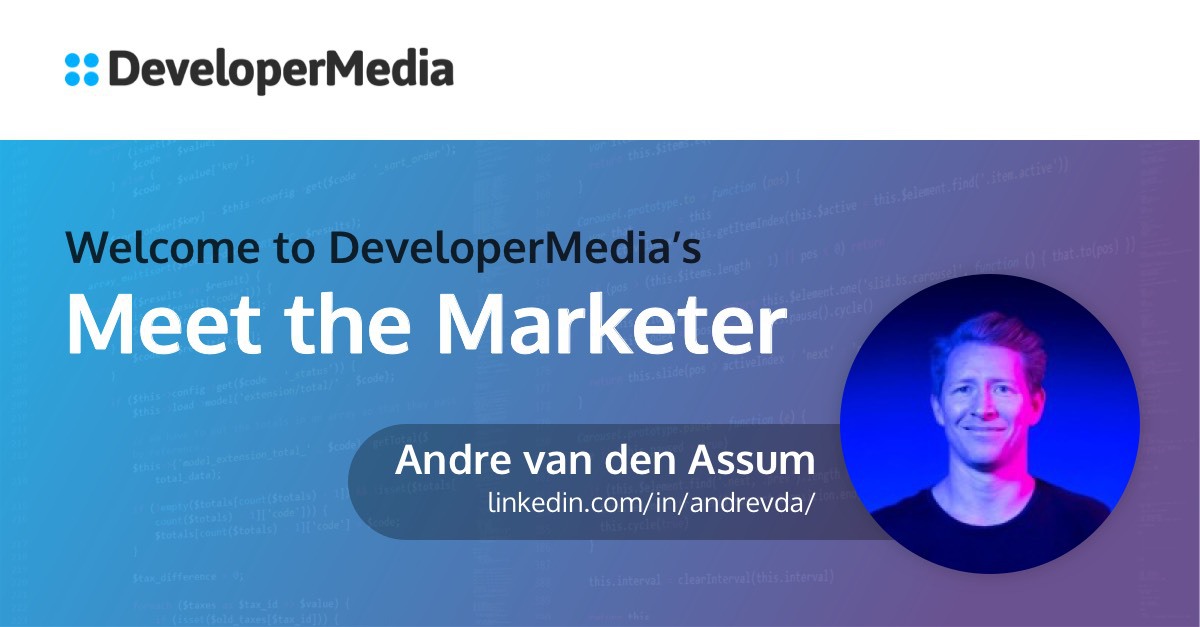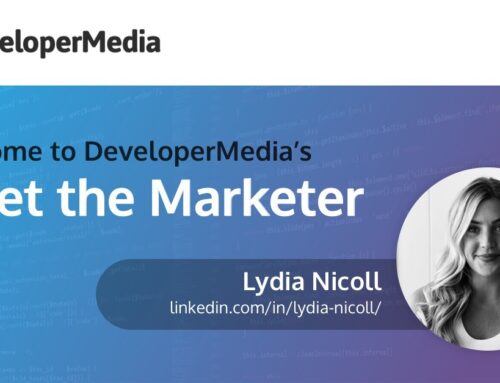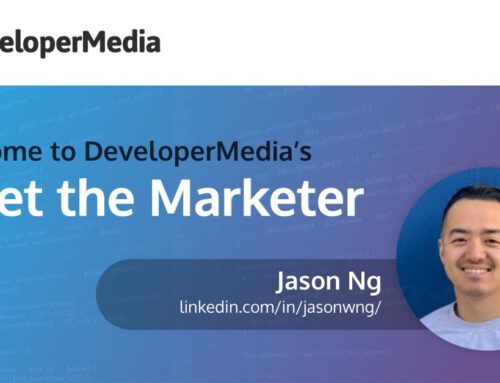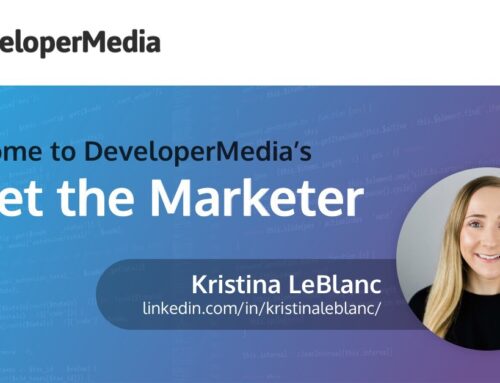Developer Marketing Insights
In Meet the Marketer, DeveloperMedia is spotlighting professionals who are focused on marketing to developers. Through this series, we want to provide you with access to and insight on your peers, like Andre van den Assum, director of marketing at Raygun, so you can learn firsthand how they market to developers. It’s also a way to share best practices, and perhaps learn something new.
Wildlife Tour Guide /Jet-Boat Driver?
Andre has had an interesting and far-flung career, but his passion for marketing is clear. Our conversation covered interesting info on his native New Zealand as well as an adventurous stint in Canada. He is currently marketing director at Raygun, an application monitoring company with a cool name, strong brand, and even cooler logo. We asked Andre a few questions designed to highlight developer marketing best practices. Our conversation is presented below, edited for length and clarity.
So, you were a jet boat driver in Canada…
I was a wildlife tour guide driving jet boats, and showing Canadians and people from around the world the wildlife in British Columbia (BC) — mainly black bears, but also eagles, caribou, moose, and other exotic animals like that.
I went to Canada as a tour guide, because in New Zealand, you are close to wildlife and learn to love and appreciate nature, but there are no bears. Because of my Kiwi accent, the way I say bear (beer), had people confused.
It was a great job. And it leaned into some of the things that are important in marketing, such as storytelling and engaging the audience which I really, really enjoy. I’d studied up on the [local] wildlife and was able to deliver an engaging hour-long tour, in a way that (if everything went right), just lit up people’s faces, and it was a lot of fun.
That was in BC, in the mountains of British Columbia, which has some similarities to my native New Zealand. We have a lot of space, and you end up engaging with and enjoying the outdoors. And I think the same thing can be said about western Canada. It’s a big country with all these mountains and wildlife.
Tell us about your role as marketing director at Raygun.
As the director of marketing, my job centers around managing lead flow. We sell B2B, and we look at our funnel, and then look at ways to improve our efforts from the channels we use — sponsorships, pay per click, SEO, down to the website.
We look at optimizing the website and the messaging, the design of the website, specific key pages, and the path we select to move our viewers into a trial. Then we look at the trial, because we have a couple of key steps there as well [which I’ll explain]:
Step one is a starter Raygun trial, which has to be activated, because Raygun is a performance- monitoring solution. Unless you’re showing data inside of Raygun, you’re not getting value out of it. It’s key to visualize that data, because it gives you actionable insights.
It shows you areas that are slow, it shows how many errors are coming in, who they’re impacting, and it connects to your repository, so you can connect it to GitHub, take action, and prove you have the healthiest software. Without showing data in our dashboard or in our product, you’re not going to get value, so a key step is activations and then converting the trial to a paid subscription.
We constantly review the onboarding flow and the onboarding content. A vast majority of our business follows a self-serve model. We build awareness, and this creates inbound traffic. People hear about us and our value proposition resonates with them and they trust us, and they eventually hit our website.
Often, with B2B, the buying journey is longer, and [the trigger] is only when a developer may have some buggy software, or something happens and then they ask, ”How about that Raygun tool?” When others know about it and can stand by it, that increases the likelihood of [that developer giving it] a real trial.
We rely on people putting it into their production or testing environments. We need to build trust into our brand in order to get developers to commit to the trial. As the Director of Marketing, I’ve got a pretty small team, so I’m overseeing the whole lead and trial flow, and doing some experiential marketing experiments along the way.
I’m always thinking about different ways to cut through the noise created by our competitors because the performance monitoring market is getting more crowded. It’s critical that we continue to find new ways to get through the clutter.
We’re doing some work now to fold in our credibility factor more organically using social proof through things like G2 and driving reviews, and integrating customer references contextually into the website. Customer quotes help reinforce value propositions as we take developers through the buying journey.
Marketing is an iterative process, and we manage and oversee a lot of moving parts. On some things we’d like to be further along, but it’s about lifting the boat from all angles and making adjustments and decisions along the way.
What do you love about developer marketing?
The developer community keeps you honest, that’s for sure! When I came to Raygun, I leaned on my prior experience and my gift of storytelling. But over the last few years, I’ve honed in on being a bit more direct and cutting down on the fluff.
Developers love stories, and they love engaging ways to deliver information. But we have become more focused, because every word or image really has to matter to our audience.
Developers are behind the scenes, solving the hard problems and creating these user experiences. Developers are the hero in the movement towards digital. From a Raygun perspective, it’s nice to give them tools to allow them to do their job more efficiently, and effectively deliver better experiences. Raygun enables them to have more visibility into their code and see how it performs in the hands of their customers.
Here in New Zealand, we’ve got a nice tech scene, and it’s great to support and partner with developers, teams, and innovative companies. That’s the part of my job that I like the best.
What are your greatest challenges?
From the beginning, it was accepted that I couldn’t quite get on the same technical level as the developers I was dealing with. I can talk at a certain level, but once I get a developer started, they’re quick to get into the nitty gritty of the code base. I’m just not there, and that’s okay because I know my limits.
I’ve kind of turned more into a facilitator, and I think it’s an advantage to be more scalable. Engineers in our team cross all the different areas with all the different languages.
I balance my ability to connect at a level that developers need. It’s finding the right people and facilitating content or conversation or asking the right questions. For example, when we have product releases and we’re creating content, we lean on the experts in our team to be able to talk technically with the developers and get into the details that developers really love to get into.
Another challenge is measuring the right things. but I’ve been in board meetings reporting on a campaign, and they say, “How many trials did you get through that channel?”
You have to set the right expectations, and have the right success metrics for various channels and stages of that buyer’s journey. Sometimes you don’t have those answers, but you have to have a bit of confidence [after] you’ve gone through quite a few of those conversations.
A common trap is that people don’t measure the right things and they end up just turning things off, because they think it’s not working, but I think perhaps they’re using the wrong metric.
What I love about digital marketing is that we can really target our audience. Even from here in New Zealand, we can get out there and find our target audience. We can drive interest and get engagement through our content to our product, from one place, and be very efficient with our spend.
What surprises you about the developer community?
The fact that the market is so massive, and yet so connected. I keep running across the same people because of the close-knit nature of the community. In general, you see a lot of the same names pop up. Developers reference them and the great contributions they make in terms of content and their opinions on things.
Who is your target audience?
There are specific types of developers who address crash reporting, performance monitoring, and user monitoring [and that’s one audience].
We’re really focused on senior engineers that come across the kind of problems we solve, who are a little bit more experienced, not entry level, so they have a little bit more input in terms of the tools that they use.
{Right now], 80% of our efforts are on senior engineers, the power users, and then 20% goes into the decision-makers, which are the CTOs, or the VPs of engineering.
How long have you been marketing to developers?
I’ve been with Raygun almost three years, and I worked as a marketing manager for another tech company for five years prior to that. I really enjoy being part of the team at Raygun. It’s a good match.
What changes have you seen over the past two years?
There’s been a lot of growth, and consequently a lot more competition, so you’ve really got to find ways to differentiate yourself and build a marketing engine. Now, you’ve really got to get specialized, and really tuned to the channels that you’re using right now, rather than trying to boil the ocean.
We’re focusing on certain channels and trying to do a really good job of creative execution so our work stands out, resonates with the audience, and works harder for us. [There’s more competition] around cost per clicks, as things like that have gotten more expensive as well.
Things are changing all the time, but for marketing, it always comes down to that funnel. You’ve got to build brand awareness. You’ve got to build trust.
With this audience, you’ve got to be genuine and provide value. You’ve got to be in it for the right reasons. We sponsor a bunch of shows. We want to support the community and the creators of those shows. We want to show commitment and give them a bit more than our competitors.
How do you track your marketing campaigns?
We use a tool called Autopilot as our CRM. We can see how we interact with our audience and our database. We drive a lot of traffic to our website. We have really successful inbound marketing. It’s a nice tool, easy to use, and I like the UI.
We don’t like to get obsessed with too many metrics like page views or lead scores. We’re modern, we’re always innovating, and we move fast. I want to share our product announcements, what our audience loves, and product enhancements, and how we build better tooling.
We were founded by engineers, and we understand the problems that developers and software teams face. We want to be a voice in the development community and show our thought leadership, and we do that through our content. Our focus areas are building trust and thought leadership.
Best practices?
Stuff like creating quality content.
And then, how are we moving that down the funnel to a point where people are going to try our product? And then how do we help them become successful? It takes time to build that relationship and not just swoop in, win the business, and swoop out.
We’re also focused on setting a cadence for our efforts at the top of the funnel. We don’t need to be in every newsletter and every podcast, because it’s expensive. We are selective, and we push out messages that fit our brand narrative, which speaks to thought leadership and product innovation.
Do you miss travelling?
I do. I think events and meeting people in real life is super important, and it’s something we are definitely going to get back to when conditions permit.
For now, [at the company level], we are still able to connect and be involved in all the different communities from New Zealand. We’re seeing solid results through our digital marketing efforts. I am looking forward to getting back on a plane, because it’s just so good to see people in the flesh and hang out and talk with them in real life.
What things do you wish you could have in your tool suite to enable you to do your job better?
I’ve always wanted to get a multi-touch attribution tool, but I’ve given up on that dream, and it’s made my life simpler. You have to keep things simple and select the right metrics for the different pieces of your marketing engine. I’ve really just tried to simplify to bring the funnel focus on delivering quality, and on being genuine contributors to the developer community.
I’d also love to start our own podcasts, and that would require some production tools.
Favorite flavor of ice cream?
When I find myself in the gelato shop, I often get the coffee flavor, so that’s probably my favorite. If they don’t have coffee, it’s chocolate.
What do you like about working with DeveloperMedia?
The support from the DeveloperMedia team has been awesome. We’ve worked together for a few years and they’re really great. They’re great partners to work with because they have our best interests in mind, and they’re flexible. They come up with ideas, and it’s easy to jump on a call with them and strategize to figure out a plan of action.
I definitely see the value in working with DeveloperMedia. They never miss a beat, they schedule things, they remind you if they need anything, and they grab great spots for you because they’ve got good relationships with great shows. I’ve got nothing but good things to say about them.
Final Words
Andre provided a wealth of information and advice around his methodology and approach to marketing to developers. Some key takeaways include:
– Marketing is an iterative process, and we manage and oversee a lot of moving parts. On some things we’d like to be further along, but it’s about lifting the boat from all angles and making adjustments and decisions along the way.
– Developers are the hero in the movement towards digital. From a Raygun perspective, it’s nice to give them tools to be able to do their job more efficiently and effectively to deliver better experiences.
– I balance my ability to connect at a level that developers need. It’s finding the right people and facilitating content or conversation, or asking the right questions.
It was great to learn about Andre and his work at Raygun, which serves the developer community all the way from New Zealand. If you want to learn more about how DeveloperMedia can help you build successful advertising campaigns and the extent of their capabilities, download the D2D Advertising Guide.
Resources
Raygun https://raygun.com/
New Zealand https://www.newzealand.com/
DeveloperMedia https://developermedia.com/
Autopilot https://autopilotapp.com/
DeveloperMedia advertising guide https://developermedia.com/d2d-marketing-an-advertising-guide/



